If you are looking to get LASIK in Portland, we can help you enjoy clear, carefree vision for all of life’s adventures.
(971) 362-2020
The Widest Range of LASIK Procedures in Portland
A lot of Portlanders get excited by the idea of LASIK and correcting their vision, but the options and technical terms can be confusing and downright intimidating.
It’s natural to feel hesitant about trusting your vision to just anyone.
Tersigni Vision provides the widest range of LASIK and LASIK alternative vision correction procedures in Portland. We take extra time to explain all of your options and answer your every question.
Imagine no more blurry vision when you get up with your newborn, seeing clearly on the drive home after your high schooler’s late-night game, or going out with friends and feeling fantastic with the confidence of seeing the world without glasses and contacts.
We want you to feel confident in your decision and cared for as an individual.
Imagine...
Doing your favorite activities untethered from glasses or contacts
Opening up your eyes in the morning with crystal-clear vision
Simplifying your routine every morning, night and each workout
Avoiding the hassles and cost of getting new glasses and contacts every six months to a year
Never losing another pair of readers
No more foggy glasses, scratched lenses, or itchy eyes
Enjoying carefree vision
Why Us?
Custom treatment options: Not just LASIK, but the full portfolio of modern vision correction options.
Our breadth of procedures means the best match for your specific needs
A patient education approach instead of high-pressure sales
Concierge service and treatment every step of the way
Minimized downtime after surgery
A renowned surgeon with advanced training and specialization in LASIK and vision correction
Dr. Tersigni calls Portland home
Don’t settle for a one-size-fits-all vision correction solution. Whether you have been tethered to glasses since second grade, just started wearing bifocals, or even if you have been told you are not a candidate for LASIK, come visit with us and see what you’re missing at Tersigni Vision.
How LASIK Works
LASIK works by using a laser to reshape your cornea to properly focus light on your retina. The cornea is the clear front cover of your eye.
How Your Eye Focuses Light
The human eye is truly a marvel. Your eye gathers light and uses two elements, the cornea and the lens, to focus the light onto the nerves at the back of your eye, the retina.
The cornea and the lens of the eye serve different but complementary functions in focusing the light:
Cornea: The cornea is the transparent, dome-shaped front part of the eye. It’s the first structure that light hits as it enters the eye and is responsible for most of the eye’s focusing power.
Lens: The lens is a transparent, flexible structure located behind the iris (the colored part of the eye). Its primary role is to fine-tune focus, adjusting the eye’s focus for seeing objects at various distances, a process known as accommodation.
Both work together to focus light on your retina. The retina is a thin layer at the back of your eyeball that contains cells sensitive to light. When light enters your eye, the retina converts it into electrical signals. These signals are sent to the brain through the optic nerve, which then interprets them as the images you see. Essentially, the retina acts like camera film or a digital sensor, capturing visual information and sending it to the brain for processing. Cones and rods are specialized cells located on your retina. Both types of cells work together to provide a complete visual picture, allowing you to see in various light conditions and perceive colors and details.
When your cornea is not shaped correctly this throws off the focus of the light.
How LASIK Corrects Nearsightedness
LASIK addresses nearsightedness by flattening the curvature of your cornea.
If your cornea is too curved, you may struggle to focus on things far away but be able to see objects nearby. This over-curvature of your cornea causes the light coming into your eye to focus too far in front of your retina. This causes your far vision to become blurry. Nearsightedness is clinically referred to as myopia.
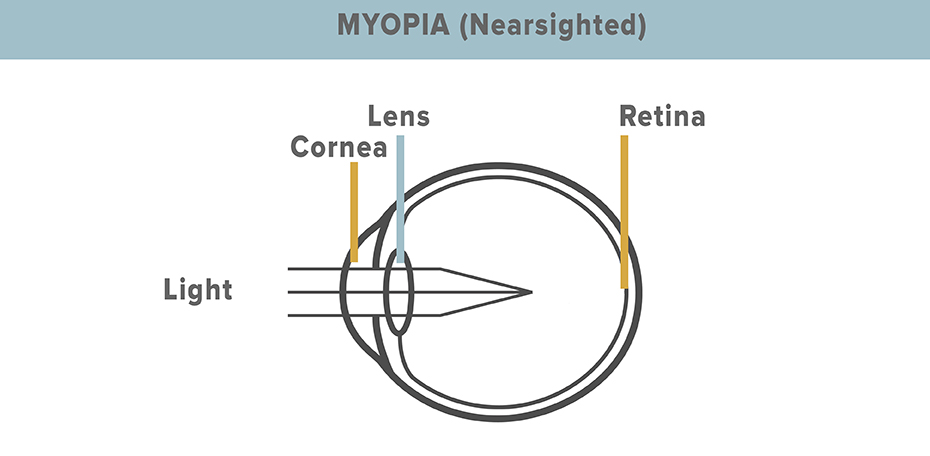 Forty-two percent of the population of Portland aged 12-54 are nearsighted, making it, by far, the most common refractive error people experience. To correct myopia, a refractive surgeon uses an excimer laser to flatten the curvature of the cornea by gently removing tissue from the center of the cornea with a cool-temperature laser beam. This flattening causes your cornea to focus light farther back on the retina, which brings distant objects into better focus.
Forty-two percent of the population of Portland aged 12-54 are nearsighted, making it, by far, the most common refractive error people experience. To correct myopia, a refractive surgeon uses an excimer laser to flatten the curvature of the cornea by gently removing tissue from the center of the cornea with a cool-temperature laser beam. This flattening causes your cornea to focus light farther back on the retina, which brings distant objects into better focus.
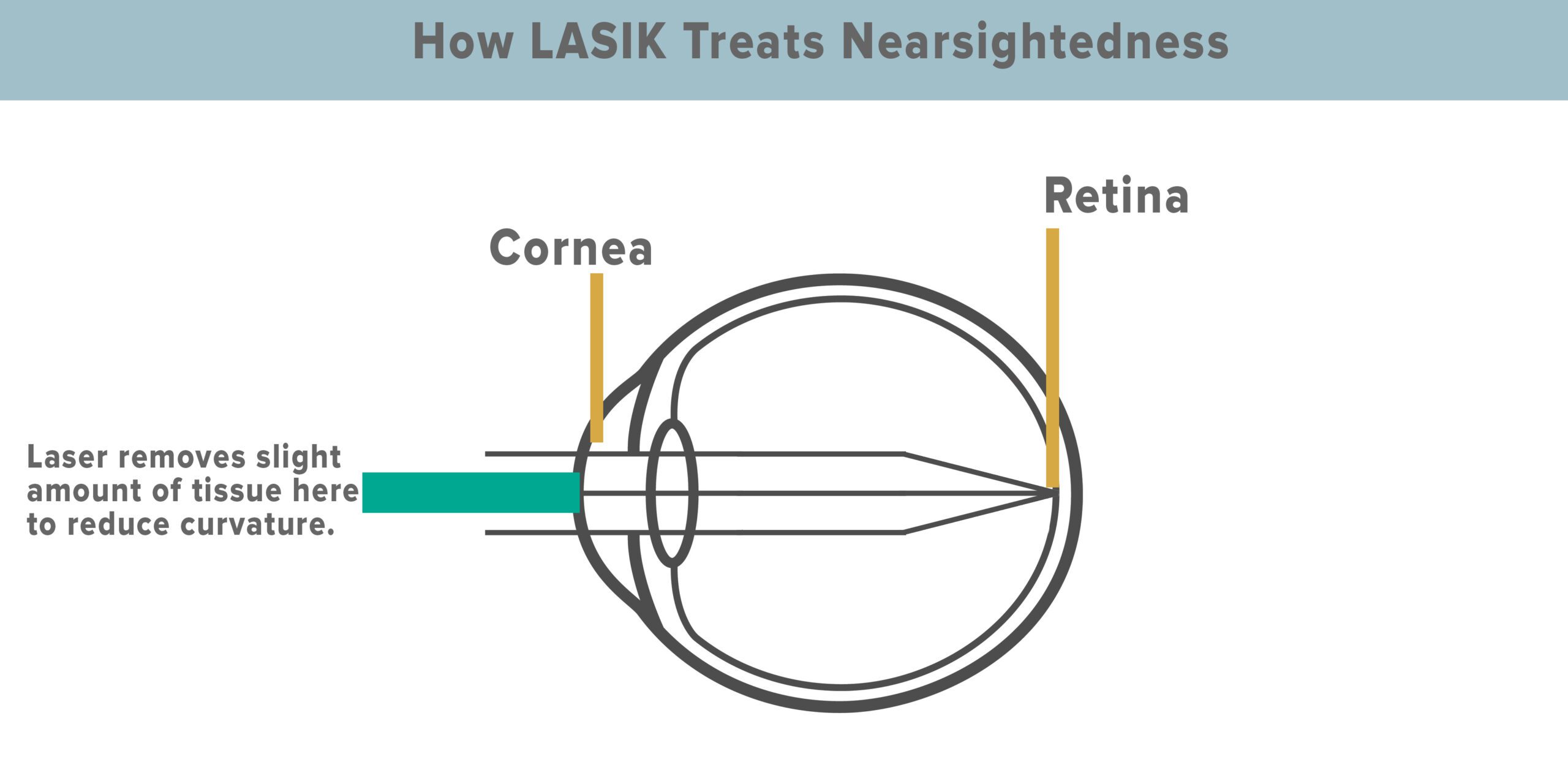 How LASIK Corrects Farsightedness
How LASIK Corrects Farsightedness
LASIK addresses farsightedness by increasing the curvature of your cornea.
If your cornea is too flat, you will struggle to focus on things nearby while being able to see objects farther away. This flattened cornea causes the light coming into your eye to focus too far behind your retina. This causes your vision to become blurry. Farsightedness is clinically referred to as hyperopia.
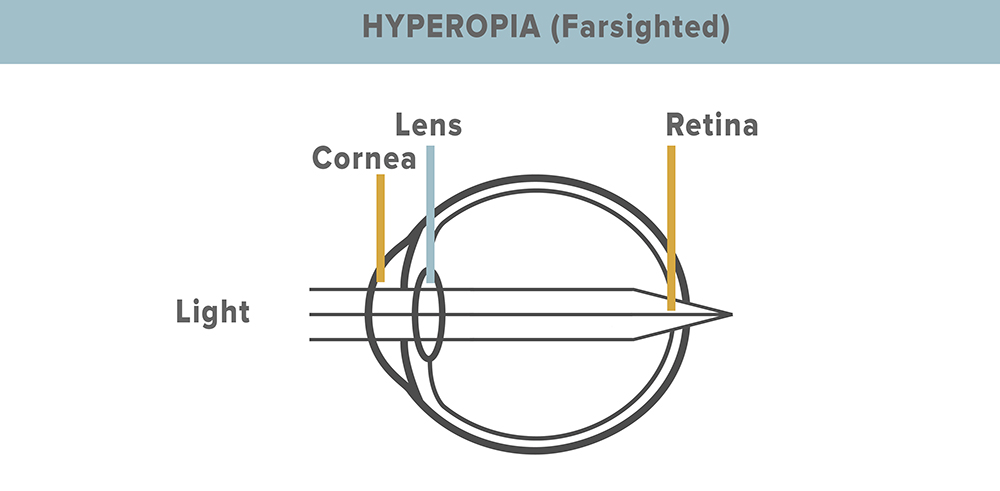 Only 5-10% of the Portland population are farsighted, making it a less common refractive error that people experience. To correct myopia, a refractive surgeon uses an excimer laser to increase the curvature of the cornea by gently removing tissue from edges of the cornea with a laser. This increased curvature causes your cornea to focus light farther forward on the retina, which brings near objects into better focus.
Only 5-10% of the Portland population are farsighted, making it a less common refractive error that people experience. To correct myopia, a refractive surgeon uses an excimer laser to increase the curvature of the cornea by gently removing tissue from edges of the cornea with a laser. This increased curvature causes your cornea to focus light farther forward on the retina, which brings near objects into better focus.
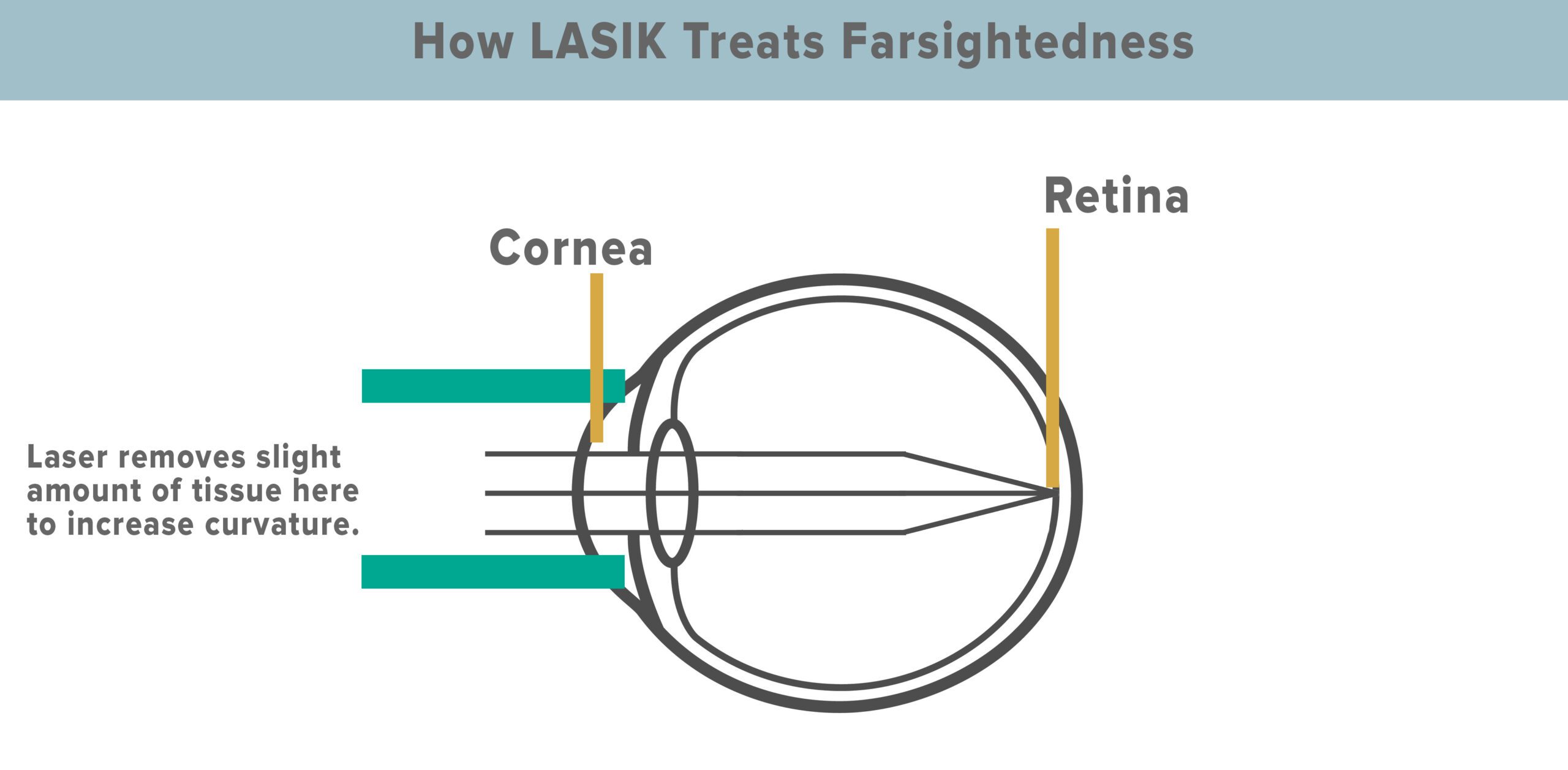 How LASIK Corrects Astigmatism
How LASIK Corrects Astigmatism
LASIK treats astigmatism by reshaping your cornea to be more evenly curved.
In astigmatism, your cornea is shaped more like a football than a perfectly round basketball, causing light to focus on multiple points in your eye, both in front of and behind the retina. This leads to blurred or distorted vision at all distances. Astigmatism is a common refractive error, often occurring alongside nearsightedness or farsightedness.
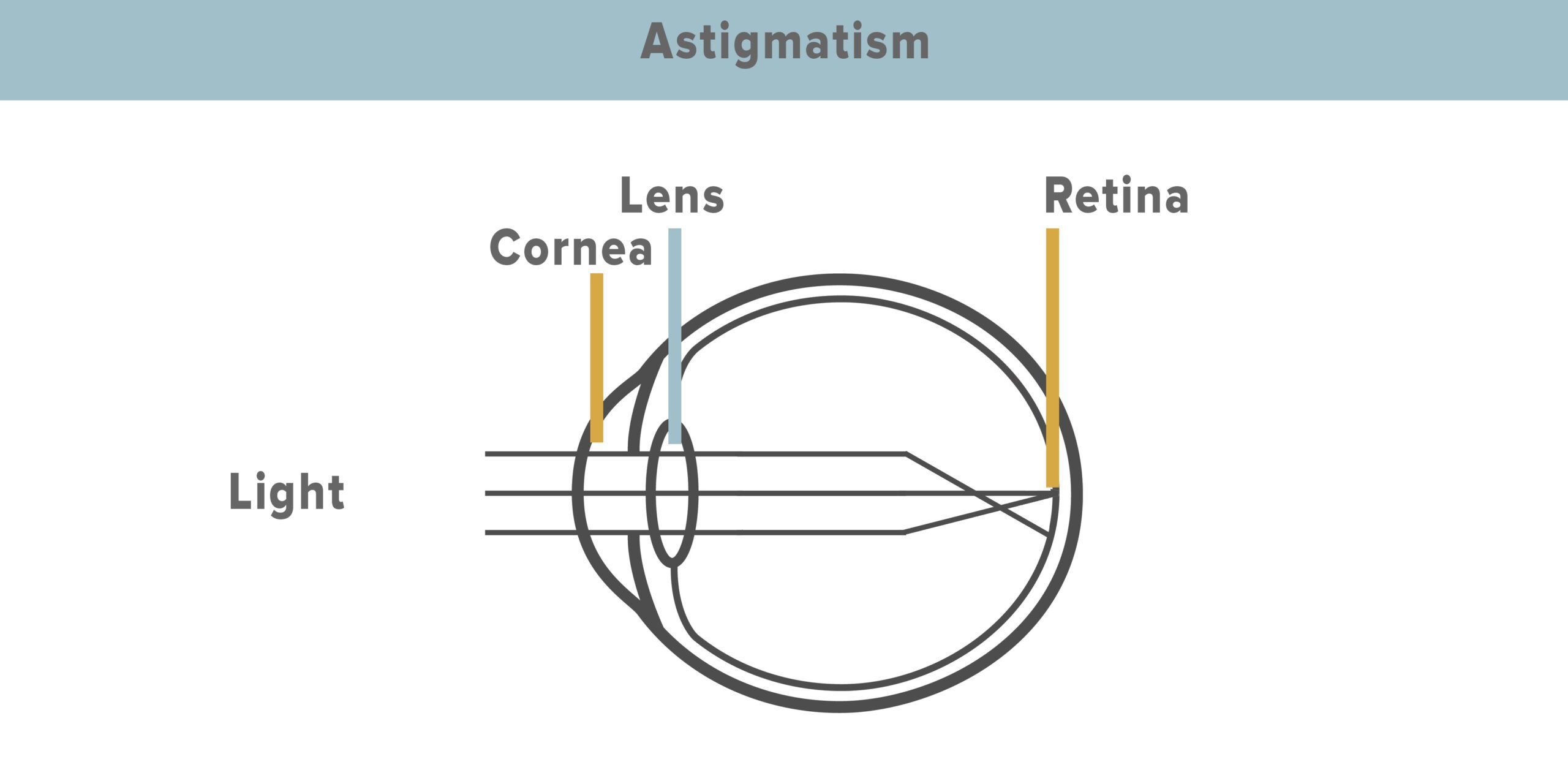 To correct astigmatism, a refractive surgeon uses an excimer laser to smooth out the irregular curvature of the cornea, focusing on specific areas to create a more uniform, spherical shape. This precise reshaping allows light to focus more directly on the retina, clearing up the blurriness and distortion caused by astigmatism.
To correct astigmatism, a refractive surgeon uses an excimer laser to smooth out the irregular curvature of the cornea, focusing on specific areas to create a more uniform, spherical shape. This precise reshaping allows light to focus more directly on the retina, clearing up the blurriness and distortion caused by astigmatism.
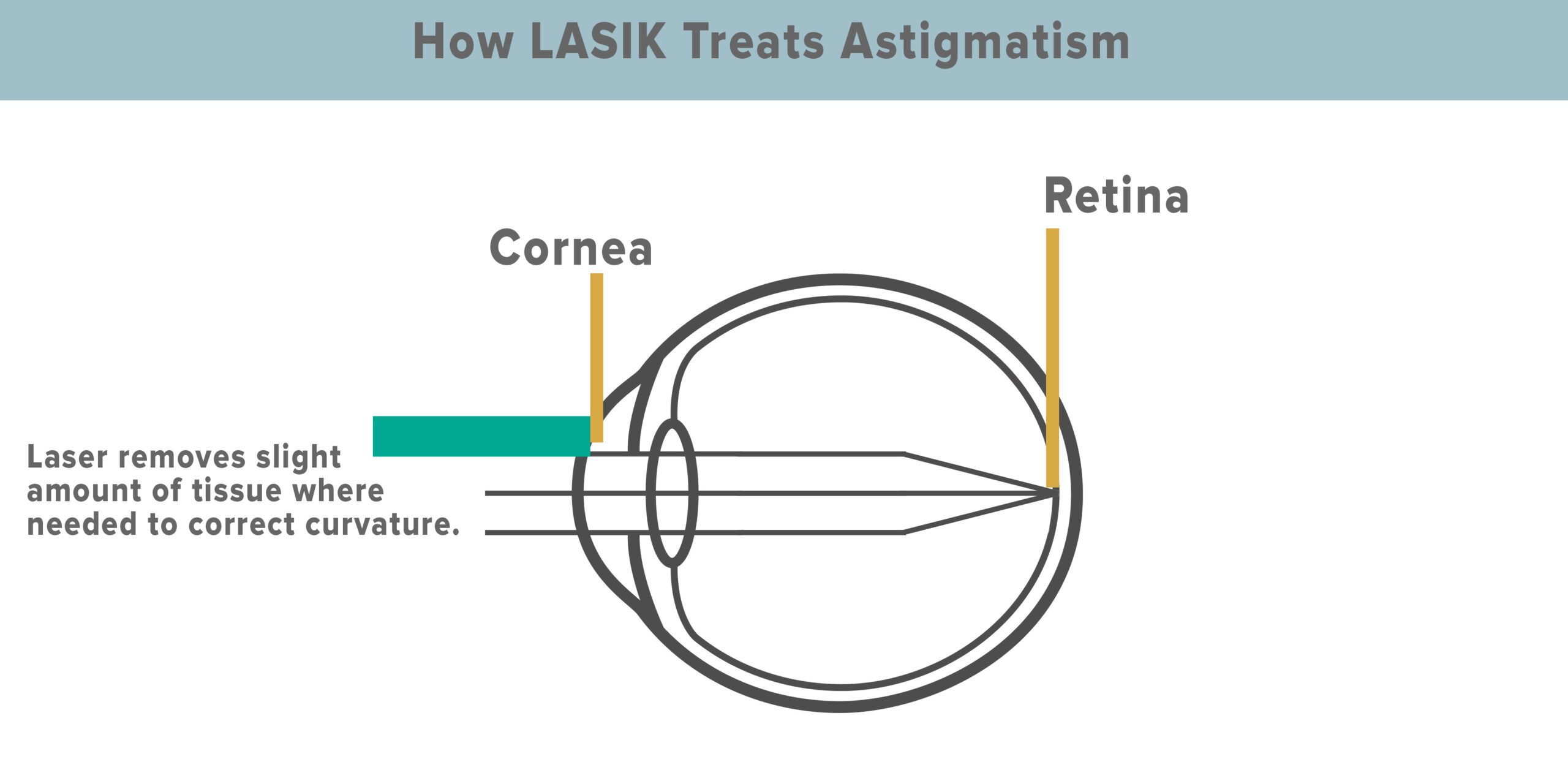 Unlike Glasses and Contacts, LASIK is a Lasting Solution
Unlike Glasses and Contacts, LASIK is a Lasting Solution
Optometrists prescribe the corrective lenses in glasses and contacts to bend the light before it reaches a misshapen cornea. This works right up to the point you remove your glasses or contacts. It’s straight back to blurry vision. As long as you rely on contacts or glasses, you are “renting” your vision. Glasses and contacts don’t address the root cause of your vision issues, a misshapen cornea. LASIK treats the root cause of your problem—your cornea. Each pair of glasses or contacts you buy is a temporary fix. When you change the shape of your cornea with LASIK, you are now treating the root issue with a permanent solution. This means you now OWN your clear vision! And owning your vision actually costs less than a lifetime of glasses and contacts.
Advanced LASIK Technology for Portland
Two laser systems are used in LASIK – a femtosecond laser and an excimer laser. Dr. Tersigni used his vast experience at previous practices, FDA clinical studies and research, and case studies to select the most advanced LASIK technology for his Portland LASIK suite to ensure each patient gets the best possible outcomes. At Tersigni Vision, you will be in the hands of a highly skilled surgeon with the most advanced technology.
The ZEISS VisuMax Femtosecond Laser
The first step of your LASIK procedure allows Dr. Tersigni to access your cornea. To do this, he uses a femtosecond laser to gently create what is called a flap with the ZEISS VisuMax. Decades ago this used to be done with a microkeratome blade, but now LASIK is 100% all-laser and blade-free thanks to femtosecond laser technology.
How You Benefit from the Zeiss VisuMax
- Advanced and Gentle: The ZEISS VisuMax uses femtosecond laser technology, known for its precise and gentle approach to eye surgery. It’s designed for fast and accurate procedures, making it a top choice for various eye surgeries. It is the most precise and gentle femtosecond laser available.
- Versatile Applications: It supports a wide range of eye surgeries, including corneal surgery, with its ability to make precise cuts and incisions, tailored to each patient’s needs.
- High-Precision Outcomes: The VisuMax’s advanced optics focus the laser beam precisely, ensuring accurate incisions at the correct depth in the cornea, resulting in smoother and more predictable surgeries.
- User-Friendly Interface: Designed for ease of use, the VisuMax features an intuitive touchscreen and software, making the surgical process more efficient for the surgeon.
- Efficient Workflow: It offers quick treatment times and is compatible with other ZEISS lasers like the MEL 90, ensuring a smooth and efficient workflow in eye surgery procedures.
- The SMILe Procedure and More: The versatility of the Zeiss Laser allows Dr. Tersigni to offer the broadest selection of vision correction procedures in Portland, including the LASIK alternative SMILe procedure. This is great news if you find you are not a LASIK candidate.
WaveLight® EX500 Excimer Laser: Reshaping Your Cornea
The excimer laser completes the second step of your procedure. Dr. Tersigni uses the excimer laser to reshape your cornea to properly focus the light your eye receives on your retina. This is called corneal ablation. This causes what you see to come into better focus.
How You Benefit from the WaveLight® EX500
- Fast and Precise: The WaveLight® EX500 Excimer Laser performs eye surgeries extremely quickly, in about 1.4 seconds for each unit of measurement (diopter) needed to correct vision. Being the fastest excimer laser available, this means faster and more accurate treatments.
- Personalization: This laser customizes the procedure for each person’s eyes. It uses special profiles to maintain the eye’s natural shape and prevent blurring or distortion of vision.
- Advanced Technology: It includes high-tech features for precise alignment and tracking of eye movements, ensuring accuracy during the procedure.
- Efficiency and Simplicity: The laser works at a high speed (500 times per second) and has technology that ensures smooth and accurate laser delivery. It also includes systems that make the process easier to manage, like measuring the thickness of the cornea without touching it.
- Integrated System: The WaveNet™ Computer Network links the laser with other diagnostic tools, streamlining information sharing making the procedure safer and more efficient.
We are committed to remaining at the forefront of LASIK and vision correction technology. The best news is this technology means that your LASIK procedure is quick, accurate, and painless. You’ll just look at a green dot and before you know it, Dr. Tersigni will be telling you your procedure is complete.
What Our Uniqueness Means for Portland
Custom treatment options and breadth of refractive procedures means…
We have more options to meet your exact vision correction needs than any other Portland practice. Maybe LASIK is the best option for you or it may be that one of our other modern LASIK alternatives will better fit your needs. We won’t squeeze you into LASIK if it’s not the best corrective procedure for you.
Also, if you have been told you are not a LASIK candidate elsewhere, there could be a vision correction procedure at Tersigni Vision that will work for you.
Individualized, patient education approach instead of high-pressure sales means…
You feel more confident about your vision correction procedure and we understand your concerns. These are your eyes, the only pair you have, not a used car you are purchasing. We take the time to answer all of your questions, no matter how long it takes.
A renowned surgeon with advanced training in LASIK and vision correction means…
You benefit from his experience of being at the forefront of LASIK and refractive surgery. Dr. Tersigni is an ophthalmologist trained by world-renowned refractive surgeons and, before returning home to Oregon, he worked at some of the most prestigious LASIK and vision correction centers in the country. In addition to being involved in numerous FDA trials for new vision correction devices and treatments, Dr. Tersigni was also one of the first surgeons in the U.S. trusted to perform the LAL procedure.
Concierge service and treatment every step of the way means…
You’ll know you are being taken care of in the best manner possible. Our listen-first approach ensures you feel comfortable with your decision. Our team ensures you are comfortable from the time you schedule your consultation to the end of your final follow-up. We get rave reviews from our patients on their experience.
Minimized downtime after surgery means…
You can get back to life as quickly as possible. We understand that you have important things to do. Depending on the procedure, some patients feel comfortable going back to work the next day.
About the Author
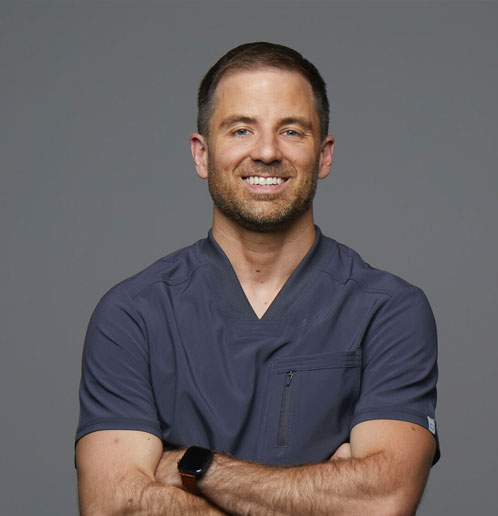 Dr. Steven Tersigni is a refractive surgeon offering LASIK and five LASIK alternatives in the Portland, Oregon area. In addition to providing customized care to each of his patients, Dr. Tersigni is an educator and researcher He obtained both his medical degree and a master’s degree in public health from Tulane University. He has been published in national journals and has been involved in 10 U.S. FDA trials.
Dr. Steven Tersigni is a refractive surgeon offering LASIK and five LASIK alternatives in the Portland, Oregon area. In addition to providing customized care to each of his patients, Dr. Tersigni is an educator and researcher He obtained both his medical degree and a master’s degree in public health from Tulane University. He has been published in national journals and has been involved in 10 U.S. FDA trials.
What is LASIK?
LASIK or Laser-assisted in situ keratomileusis, is one of the most successful surgical procedures in the world today. The more modern version of this laser vision correction procedure, Sub-Bowman keratomileusis (SBK), is just as successful and can be used to treat farsightedness (hyperopia), nearsightedness (myopia), presbyopia, and astigmatism. Doctor Tersigni and Tersigni Vision use information gained from your Tersigni Vision Advanced Ocular Analysis, performed early in the process, to fully map the eye’s interior and surface to ensure complete precision during the LASIK procedure.
And, as technology has advanced, there are now many patients who have previously been told they are not a candidate either because they were too old, too young, or have astigmatism, who can now have LASIK eye surgery or one of the modern LASIK alternatives offered at Tersigni Vision.
Candidacy Questions
How can LASIK surgery at Tersigni Vision improve my quality of life?
Your quality of life can be greatly enhanced by the clearer vision LASIK provides. The reduced dependence on corrective lenses, such as eyeglasses and contact lenses, improves your comfort and confidence in everyday life.
Who is a candidate for LASIK surgery?
When determining who are the best candidates for LASIK laser vision correction surgery there are several factors to consider. LASIK may be able to help overcome refractive error and achieve clear vision if you:
- have farsightedness, nearsightedness, presbyopia, or astigmatism
- have had stable eyeglasses or contact prescription for a year
- are at least 18 years old
- are in good health
Even if you are not a candidate for LASIK, you may be a candidate for one of the many modern LASIK alternatives that we provide at Tersigni Vision.
Does Tersigni Vision offer refractive surgery for those who aren’t suitable for LASIK?
Yes, Tersigni Vision provides the full range of refractive surgery options beyond LASIK for those who aren’t suitable candidates. These may include PRK (Photorefractive Keratectomy), ICL (Implantable Collamer Lens), RLE (Refractive Lens Exchange), and more. There are many tools and technologies available to us to help eliminate your need for an eyeglass prescription.
How is my eye examined before LASIK surgery at Tersigni Vision?
At Tersigni Vision, we perform a comprehensive eye exam before recommending LASIK. This includes evaluating your cornea, retina, eye pressure, and other aspects of your eye health. This guarantees that the process is appropriate and tailored to your particular needs.
How does LASIK address astigmatism?
At Tersigni Vision, LASIK treats astigmatism by reshaping the cornea to correct the uneven light refraction, enhancing your visual perception and reducing your dependence on corrective lenses.
Can LASIK make you go blind?
There haven’t been any incidents of blindness directly linked to LASIK reported. The safest elective surgery in the world, according to research, is LASIK surgery. Although there is still risk with any medical procedure, wearing contact lenses actually has a significantly higher risk of eye damage, visual impairment, and vision loss than does laser eye surgery. To minimize any potential hazards, Tersigni Vision will only perform LASIK on approved patients with healthy eyes. We will spend as much time as you need to make sure you understand the advantages and disadvantages of LASIK so you can decide if it is the ideal procedure for you.
What is the Food and Drug Administration (FDA)’s stance on LASIK?
The FDA has approved LASIK as a safe and effective procedure for correcting certain vision problems. At Tersigni Vision, we only use FDA-approved technology and techniques for LASIK and other vision correction procedures.
Can dry eye syndrome affect my LASIK surgery results?
LASIK surgery outcomes may be impacted by dry eye syndrome. Because of this, we extensively evaluate your eye health before recommending LASIK, assessing for dry eyes among other things. Prior to LASIK, we might recommend treatment if you have dry eyes.
Can I get LASIK surgery at Tersigni Vision if I have keratoconus?
LASIK may be ineffective or inappropriate for someone with keratoconus, which is a disease of the cornea. For individuals with keratoconus, however, we provide a number of alternative vision correction solutions. Dr. Tersigni will perform a thorough eye examination so that we can choose the most appropriate course of action for you.
Can having glaucoma affect my eligibility for LASIK surgery at Tersigni Vision?
Yes, glaucoma can affect your eligibility for LASIK surgery, but it doesn’t automatically exclude you from being a candidate. We will do a thorough eye exam to assess your unique circumstances and offer the best guidance.
How does LASIK affect the retina?
LASIK is performed on the cornea, which is on the front of the eye, and the retina is not directly involved. To guarantee overall eye health and suitability for the procedure, we do perform a careful retinal examination before surgery.
How Can I Pay for LASIK?
Even though there is an upfront expense associated with a vision correction surgery, for the majority of patients, it ultimately works out to be substantially less than the lifetime cost of glasses and contacts.
All standard payment methods are accepted by Tersigni Vision, including cash, credit card, checks, and more. While LASIK and other laser vision correction surgeries are usually not covered by insurance, we can also work with Medical Savings Accounts (MSAs) and Health Savings Accounts (HSAs). A LASIK procedure in Portland is also tax-deductible, and we have financing options to best fit your budget.
See our Affordable Financing Options
Technology Questions
What technology does Tersigni Vision use for laser surgery?
Tersigni Vision uses state-of-the-art femtosecond laser technology and an excimer laser for LASIK surgery. The femtosecond laser creates a thin surgical flap in the cornea, and the excimer laser is then used to reshape the underlying corneal tissue with incredible precision.
What role does the excimer laser play in LASIK surgery at Tersigni Vision?
The Excimer laser plays a key role in LASIK surgery, precisely removing corneal tissue to reshape the cornea. This helps correct refractive errors such as near-sightedness, far-sightedness, and astigmatism, improving your visual acuity.
What is SBK?
LASIK was initially conducted with a microkeratome, or mechanically controlled blade. Although it was an excellent procedure, it wasn’t quite as precise as many surgeons would have liked. However, it was safe and helped a lot of patients.
From this desire for better precision came the femtosecond laser used in SBK. This laser is more accurate, comfortable, precise and predictable. This has allowed many patients who were previously excluded from LASIK to be able to enjoy the freedom and confidence that SBK LASIK provides.
What is Wavefront?
The latest technology in LASIK includes wavefront-optimized, wavefront-guided, and topography-guided LASIK procedures. These are collectively referred to as “custom” treatments. With the aid of these technologies, Dr. Tersigni can provide a more magnified image of the tiniest details of the eye. He does this by using precise maps of the cornea. This allows for a truly customized treatment and can sometimes help you have better vision than you can get in glasses or contacts.
What is the importance of accuracy and precision in LASIK surgery at Tersigni Vision?
A good LASIK procedure requires accuracy and precision at all times. With the help of corneal topography mapping and our excimer laser technology, we can precisely reshape your cornea to enhance your visual acuity.
How is corneal topography utilized in LASIK?
Corneal topography allows us to map the surface of your cornea, identifying irregularities and aiding in precise and individualized treatment planning. It ensures that the LASIK surgery improves your eye health and visual acuity with the highest accuracy and precision.
How does Tersigni Vision use wavefront technology in LASIK?
Wavefront technology helps us create a detailed 3D map of your eye, capturing minute imperfections that traditional methods may miss. The excimer laser is then guided by this information during LASIK surgery, perhaps resulting in better results and visual quality.
Procedure Question
What does the Day of Your LASIK Procedure look like?
Despite the procedure only taking about 15 minutes, on the day of your LASIK eye surgery, you should expect to be at Tersigni Vision in Portland for approximately two hours. You will also require someone to drive you home.
Special clothing does not need to be worn for the procedure. Sometimes, we may repeat some of the tests conducted during your Tersigni Vision Advanced Ocular Analysis to double-check that everything is accounted for.
When it’s time for the actual procedure, you will be given eye-numbing drops, and a gentle eyelid holder will be put in place so there will be no need to worry about blinking. The laser eye correction will then be performed first by creating the surgical flap with the femto-second laser, and then comes the excimer laser treatment, with each step usually taking less 20 seconds per eye.
How long does LASIK surgery take?
Dr. Tersigni, who performs LASIK in Portland, Oregon, has his patients expect to spend about 2-3 hours at our vision correction center on the day of their procedure. This allows them plenty of time to fill out any necessary paperwork, perform any necessary testing, complete the LASIK eye surgery (which only takes around 15 minutes), then take time to recover before leaving with someone to drive them home.
Do I need anesthesia during LASIK surgery?
Yes, we numb your eye with local anaesthetic in the form of eye drops during the treatment to ensure you feel as little discomfort as possible.
After LASIK Questions
After your LASIK procedure, your surgical technicians will give you post-operative instructions, as well as protective eye shields to use during sleep the first two nights.
Most LASIK eye surgery patients experience little, if any, discomfort during or after the procedure, though it’s not uncommon for your vision to be blurry for the first two to three hours. However, it won’t be long before you can see vivid, clear details without the use of glasses or contact lenses.
Most patients can return to work and daily routine the day following their surgery. Your surgeon will schedule a follow-up appointment for the day after your surgery to ensure that everything is healing correctly. At this appointment you will be cleared to return to regular activities.
How long does LASIK last?
The changes made to the eye’s cornea during laser eye surgery are permanent and should last the rest of your life. However, the eye will continue to age and change along with the rest of your body and those aging changes (most commonly presbyopia and cataracts) can affect your vision, leading to the need for reading glasses. Eventually, most everyone will need cataract surgery when they get older. Rarely, there are occasions where a LASIK enhancement is needed if the original surgery doesn’t achieve the desired results or your eye changes significantly for some other medical reason.
Will I need contact lenses or glasses after LASIK surgery?
After successful LASIK surgery, most patients no longer require contact lenses or need to wear glasses for clear vision. In the rare event of residual refractive error, temporary use of contact lenses or glasses may be needed.
Questions about Tersigni Vision and Dr. Tersigni
Does Tersigni Vision in Portland, Oregon provide LASIK surgery?
Yes, Tersigni Vision is proud to provide Portland LASIK eye surgery services to residents in Portland, Oregon and throughout the Pacific Northwest region.
What is the significance of board certification for a LASIK surgeon?
Board certification is critical as it confirms the LASIK surgeon has met specific training, skill, and experience standards. Dr. Tersigni is a Doctor of Medicine (M.D.) with advanced training in LASIK and vision correction.
How does Tersigni Vision maintain a clean and safe clinic environment?
Tersigni Vision strictly adheres to the highest hygiene and safety standards to prevent infections. This includes frequent sanitization of our premises and surgical tools, use of personal protective equipment, and rigorous hand hygiene practices.
What is the difference between optometry and ophthalmology?
They are not the same even though they are both frequently referred to as eye doctors. Routine eye exams and the prescription of corrective lenses (such as glasses) are the main areas of focus in optometry. The comprehensive medical and surgical treatment of the eyes and visual system is the emphasis of the medical speciality of ophthalmology. Dr. Tersigni is a fellowship trained ophthalmologist and vision correction surgeon. This requires much more training than for an optometrist. An ophthalmologist has a medical degree and is an M.D. An optometrist does not have a full medical degree and is an O.D.
What qualifications does the physician at Tersigni Vision hold?
Our lead physician, Dr. Tersigni, is a fellowship trained ophthalmologist holding an M.D. degree. He is an expert in LASIK and other forms of refractive surgery and has a wealth of knowledge and experience in the field of ophthalmology.
How does Tersigni Vision ensure patient satisfaction?
Patient satisfaction is at the heart of what we do at Tersigni Vision. To guarantee the best outcomes and a relaxing patient experience, we maintain open communication, offer individualized care, and use cutting-edge technology.
See the first article in our LASIK FAQ series: How Long Do The Results of LASIK Last?
Dr. Tersigni calls Portland home
You won’t get LASIK from a surgeon flown in from another part of the country like at some of the big-box, discount LASIK providers. Dr. Tersigni lives here with his family. When it’s time for a follow-up, he is available. We see our practice as a long-term investment into the Portland, Oregon community.